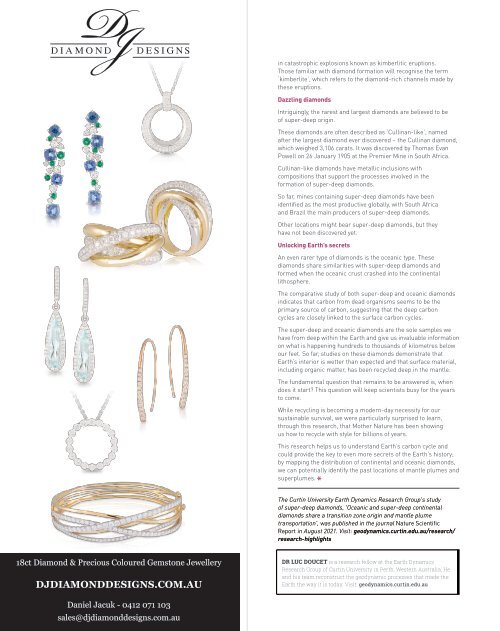Create successful ePaper yourself
Turn your PDF publications into a flip-book with our unique Google optimized e-Paper software.
in catastrophic explosions known as kimberlitic eruptions.<br />
Those familiar with diamond formation will recognise the term<br />
‘kimberlite’, which refers to the diamond-rich channels made by<br />
these eruptions.<br />
Dazzling diamonds<br />
Intriguingly, the rarest and largest diamonds are believed to be<br />
of super-deep origin.<br />
These diamonds are often described as ‘Cullinan-like’, named<br />
after the largest diamond ever discovered – the Cullinan diamond,<br />
which weighed 3,106 carats. It was discovered by Thomas Evan<br />
Powell on 26 January 1905 at the Premier Mine in South Africa.<br />
Cullinan-like diamonds have metallic inclusions with<br />
compositions that support the processes involved in the<br />
formation of super-deep diamonds.<br />
So far, mines containing super-deep diamonds have been<br />
identified as the most productive globally, with South Africa<br />
and Brazil the main producers of super-deep diamonds.<br />
Other locations might bear super-deep diamonds, but they<br />
have not been discovered yet.<br />
Unlocking Earth’s secrets<br />
An even rarer type of diamonds is the oceanic type. These<br />
diamonds share similarities with super-deep diamonds and<br />
formed when the oceanic crust crashed into the continental<br />
lithosphere.<br />
The comparative study of both super-deep and oceanic diamonds<br />
indicates that carbon from dead organisms seems to be the<br />
primary source of carbon, suggesting that the deep carbon<br />
cycles are closely linked to the surface carbon cycles.<br />
The super-deep and oceanic diamonds are the sole samples we<br />
have from deep within the Earth and give us invaluable information<br />
on what is happening hundreds to thousands of kilometres below<br />
our feet. So far, studies on these diamonds demonstrate that<br />
Earth’s interior is wetter than expected and that surface material,<br />
including organic matter, has been recycled deep in the mantle.<br />
The fundamental question that remains to be answered is, when<br />
does it start? This question will keep scientists busy for the years<br />
to come.<br />
While recycling is becoming a modern-day necessity for our<br />
sustainable survival, we were particularly surprised to learn,<br />
through this research, that Mother Nature has been showing<br />
us how to recycle with style for billions of years.<br />
This research helps us to understand Earth’s carbon cycle and<br />
could provide the key to even more secrets of the Earth’s history;<br />
by mapping the distribution of continental and oceanic diamonds,<br />
we can potentially identify the past locations of mantle plumes and<br />
superplumes.<br />
The Curtin University Earth Dynamics Research Group's study<br />
of super-deep diamonds, 'Oceanic and super-deep continental<br />
diamonds share a transition zone origin and mantle plume<br />
transportation', was published in the journal Nature Scientific<br />
Report in August <strong>2021</strong>. Visit: geodynamics.curtin.edu.au/research/<br />
research-highlights<br />
18ct Diamond & Precious Coloured Gemstone <strong>Jeweller</strong>y<br />
DJDIAMONDDESIGNS.COM.AU<br />
DR LUC DOUCET is a research fellow at the Earth Dynamics<br />
Research Group of Curtin University in Perth, Western Australia. He<br />
and his team reconstruct the geodynamic processes that made the<br />
Earth the way it is today. Visit: geodynamics.curtin.edu.au<br />
Daniel Jacuk - 0412 071 103<br />
sales@djdiamonddesigns.com.au


















